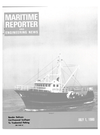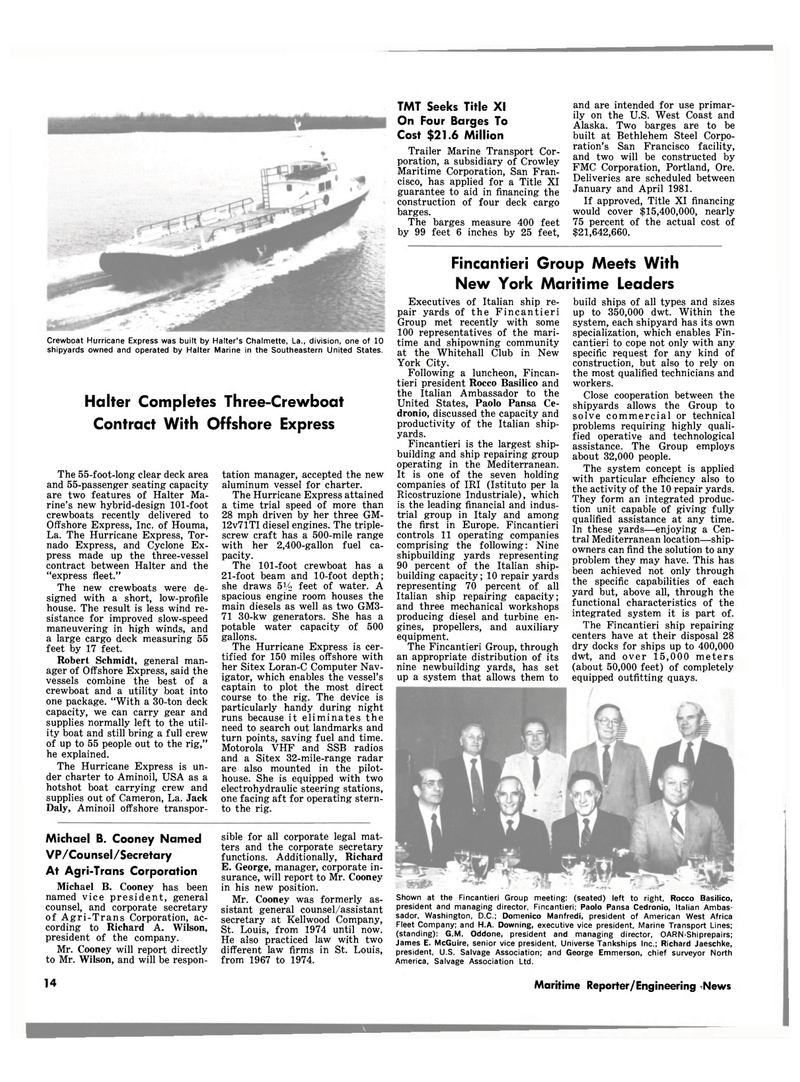
Page 12: of Maritime Reporter Magazine (July 1980)
Read this page in Pdf, Flash or Html5 edition of July 1980 Maritime Reporter Magazine
Crewboat Hurricane Express was built by Halter's Chalmette, La., division, one of 10 shipyards owned and operated by Halter Marine in the Southeastern United States.
Halter Completes Three-Crewboat
Contract With Offshore Express
The 55-foot-long clear deck area and 55-passenger seating capacity are two features of Halter Ma- rine's new hybrid-design 101-foot crewboats recently delivered to
Offshore Express, Inc. of Houma,
La. The Hurricane Express, Tor- nado Express, and Cyclone Ex- press made up the three-vessel contract between Halter and the "express fleet."
The new crewboats were de- signed with a short, low-profile house. The result is less wind re- sistance for improved slow-speed maneuvering in high winds, and a large cargo deck measuring 55 feet by 17 feet.
Robert Schmidt, general man- ager of Offshore Express, said the vessels combine the best of a crewboat and a utility boat into one package. "With a 30-ton deck capacity, we can carry gear and supplies normally left to the util- ity boat and still bring a full crew of up to 55 people out to the rig," he explained.
The Hurricane Express is un- der charter to Aminoil, USA as a hotshot boat carrying crew and supplies out of Cameron, La. Jack
Daly, Aminoil offshore transpor- tation manager, accepted the new aluminum vessel for charter.
The Hurricane Express attained a time trial speed of more than 28 mph driven by her three GM- 12v71TI diesel engines. The triple- screw craft has a 500-mile range with her 2,400-gallon fuel ca- pacity.
The 101-foot crewboat has a 21-foot beam and 10-foot depth; she draws 5% feet of water. A spacious engine room houses the main diesels as well as two GM3- 71 30-kw generators. She has a potable water capacity of 500 gallons.
The Hurricane Express is cer- tified for 150 miles offshore with her Sitex Loran-C Computer Nav- igator, which enables the vessel's captain to plot the most direct course to the rig. The device is particularly handy during night runs because it eliminates the need to search out landmarks and turn points, saving fuel and time.
Motorola VHF and SSB radios and a Sitex 32-mile-range radar are also mounted in the pilot- house. She is equipped with two electrohydraulic steering stations, one facing aft for operating stern- to the rig.
Michael B. Cooney Named
VP/Counsel/Secretary
At Agri-Trans Corporation
Michael B. Cooney has been named vice president, general counsel, and corporate secretary of Agri-Trans Corporation, ac- cording to Richard A. Wilson, president of the company.
Mr. Cooney will report directly to Mr. Wilson, and will be respon- sible for all corporate legal mat- ters and the corporate secretary functions. Additionally, Richard
E. George, manager, corporate in- surance, will report to Mr. Cooney in his new position.
Mr. Cooney was formerly as- sistant general counsel/assistant secretary at Kellwood Company,
St. Louis, from 1974 until now.
He also practiced law with two different law firms in St. Louis, from 1967 to 1974.
TMT Seeks Title XI
On Four Barges To
Cost $21.6 Million
Trailer Marine Transport Cor- poration, a subsidiary of Crowley
Maritime Corporation, San Fran- cisco, has applied for a Title XI guarantee to aid in financing the construction of four deck cargo barges.
The barges measure 400 feet by 99 feet 6 inches by 25 feet, and are intended for use primar- ily on the U.S. West Coast and
Alaska. Two barges are to be built at Bethlehem Steel Corpo- ration's San Francisco facility, and two will be constructed by
FMC Corporation, Portland, Ore.
Deliveries are scheduled between
January and April 1981.
If approved, Title XI financing would cover $15,400,000, nearly 75 percent of the actual cost of $21,642,660.
Fincantieri Group Meets With
New York Maritime Leaders
Executives of Italian ship re- pair yards of the Fincantieri
Group met recently with some 100 representatives of the mari- time and shipowning community at the Whitehall Club in New
York City.
Following a luncheon, Fincan- tieri president Rocco Basilico and the Italian Ambassador to the
United States, Paolo Pansa Ce- dronio, discussed the capacity and productivity of the Italian ship- yards.
Fincantieri is the largest ship- building and ship repairing group operating in the Mediterranean.
It is one of the seven holding companies of IRI (Istituto per la
Ricostruzione Industriale), which is the leading financial and indus- trial group in Italy and among the first in Europe. Fincantieri controls 11 operating companies comprising the following: Nine shipbuilding yards representing 90 percent of the Italian ship- building capacity; 10 repair yards representing 70 percent of all
Italian ship repairing capacity; and three mechanical workshops producing diesel and turbine en- gines, propellers, and auxiliary equipment.
The Fincantieri Group, through an appropriate distribution of its nine newbuilding yards, has set up a system that allows them to build ships of all types and sizes up to 350,000 dwt. Within the system, each shipyard has its own specialization, which enables Fin- cantieri to cope not only with any specific request for any kind of construction, but also to rely on the most qualified technicians and workers.
Close cooperation between the shipyards allows the Group to solve commercial or technical problems requiring highly quali- fied operative and technological assistance. The Group employs about 32,000 people.
The system concept is applied with particular efficiency also to the activity of the 10 repair yards.
They form an integrated produc- tion unit capable of giving fully qualified assistance at any time.
Tn these yards—enjoying a Cen- tral Mediterranean location—ship- owners can find the solution to any problem they may have. This has been achieved not only through the specific capabilities of each yard but, above all, through the functional characteristics of the integrated system it is part of.
The Fincantieri ship repairing centers have at their disposal 28 dry docks for ships up to 400,000 dwt, and over 15,000 meters (about 50,000 feet) of completely equipped outfitting quays.
Shown at the Fincantieri Group meeting: (seated) left to right, Rocco Basilico, president and managing director, Fincantieri; Paolo Pansa Cedronio, Italian Ambas- sador, Washington, D.C.; Domenico Manfredi, president of American West Africa
Fleet Company; and H.A. Downing, executive vice president, Marine Transport Lines; (standing): G.M. Oddone, president and managing director, OARN-Shiprepairs;
James E. McGuire, senior vice president, Universe Tankships Inc.; Richard Jaeschke, president, U.S. Salvage Association; and George Emmerson, chief surveyor North
America, Salvage Association Ltd. 14 Maritime Reporter/Engineering News

 11
11

 13
13
